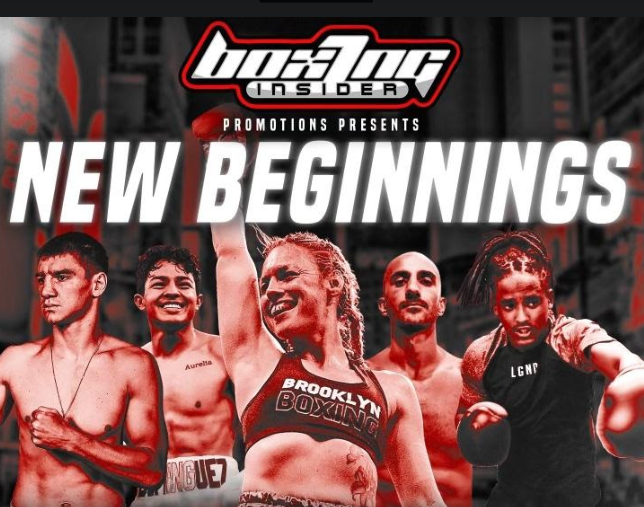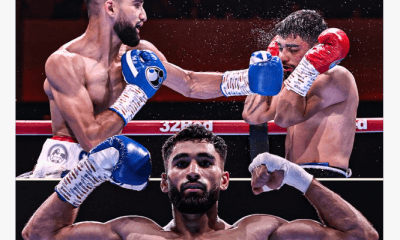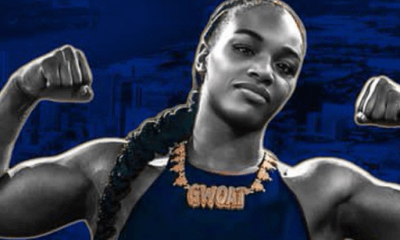Featured Articles
The Hauser Report: A Promoter’s Pro Debut

The phrase “pro debut” is often heard in conjunction with fighters. But promoters make pro debuts too. On October 13 at Sony Hall in the heart of Times Square in New York, Larry Goldberg made his pro debut.
Goldberg, age 45, grew up in and around Atlantic City where he fell in love with boxing. He has an internet-marketing background and, in 1997, founded BoxingInsider.com. In the past, he’d promoted amateur fight cards. Now he was going pro.
If Goldberg’s pro debut had been in Montana or Kansas, it might have been similar to his amateur experiences. But it was in New York. Promoting a professional fight card under the best of circumstances is like herding twenty cats across a football field while a game is in progress. When promoting in New York, think fifty cats.
The New York State Athletic Commission has more rigorous protocols for promoters than any other state. For example, the fighter medical insurance required in New York costs $1,645 per bout. That’s $9,870 for a six-bout card. Line item costs such as hotel rooms for fighters and their teams are also higher in New York than in other jurisdictions.
Virtually everyone wants something for free when dealing with a promoter. Promoting a fight card can be analogous to planning a six-figure wedding on a five-figure budget.
“It’s my first show,” Goldberg acknowledged during fight week. “There’s so much to do. I’m learning and I’m making some mistakes. I’ll lose some money; I hope not too much. But it’s a start.”
Sony Hall is a difficult venue for a boxing promotion. Finding space for changing rooms, medical examinations, and other requisite areas is a task unto itself. Because of the building’s configuration, it costs three times more than the norm to bring the ring in and out.
Goldberg was promoting the October 13 event in association with DiBella Entertainment.
“Larry knows that he can’t make money in Sony Hall,” Lou DiBella (who was in Australia for Devin Haney vs. George Kambosos) noted. “But he’s learning the ropes. It’s like a graduate course in promoting. And it costs money to get an education.”
One might be forgiven for likening Goldberg’s “education” to a diploma from Trump University. The tuition is high, often without much hope of a meaningful return. Ultimately, boxing maven Eric Bottjer was brought in to help the promotion with compliance issues and other matters.
“Eric was a life-saver,” Larry said afterward. “I don’t want to think about what might have happened without him.”
Goldberg hired his own production team and arranged for the fights to be streamed live on BXNG TV with Randy Gordon and Gerry Cooney handling the commentary. He hired a roundcard girl on the morning of the fights. Matt Competello (who Larry has worked with in the amateurs) was brought in as the ring announcer.
The New York State Athletic Commission had limited the number of fights that would be allowed on the card to six because of the cramped quarters in the back of the house. Ticket prices ranged from $102 to $325.
One fight fell out when a fighter who, Goldberg says, agreed to a $3,000 purse refused to get on a plane and come to New York unless his purse was increased to $5,000. That left Larry with only five fights. And he had to pay the $1,645 insurance fee for the cancelled fight because it had already been bonded.
Heather Hardy was Goldberg’s headline attraction and had gone beyond the role of being a fighter to help enormously in putting together the pieces of the promotion. Several opponents for Heather fell out. And for good measure, it rained on fight night which threatened to put a damper on last-minute ticket sales.
Dave McWater (the 2020 BWAA “manager of the year”) manages Ivan Golub who was in the second bout of the evening. Sitting in Sony Hall before the fights began, McWater reminisced about his own experience as a promoter.
“Years ago,” McWater recalled, “I backed Don Elbaum on a show in Connecticut. Don assured me that we’d sell 5,000 tickets. About an hour before the first fight, I went to the box office and we’d sold 259. After that, I decided I’d be better off managing than promoting.”
Then the gods smiled on Goldberg. Surprisingly, walk-up sales were good. Sony Hall nearly sold out. The venue was jammed. The seating was chaotic with close quarters everywhere from ringside to the standing room area by the bar. But all of the sightlines were good.
The ring canvas was gray, not powder blue, and the ring ropes were black. The overhead lights were dimmer than the norm. All of that when combined with the unusually close quarters, gave the evening an old-time fight-club vibe.
The fights moved smoothly from one to the next without the long delays occasioned by the demands of bigtime television.
Fight #1 saw Petros Ananyan (16-3-2, 7 KOs) face off against Paulo Cesar Galdino (12-6, 8 KOs) in a super-lightweight contest. Neither man had much defense and both men got hit a lot. But Ananyan hit harder and Cesar got hit more often leading to a sixth-round stoppage. The fight was notable because Freddie Roach was in Ananyan’s corner and the venue was set up in a way that waiters with plates full of chicken tenders and fried calamari kept walking in front of Roach while rounds were going on. “I did wonder what the f*** was going on,” Freddie said afterward.
Ivan Golub (20-1, 15 KOs) vs. Wesley Tucker (15-3, 9 KOs, 1 KO by) was the second bout. Golub was arguably the most accomplished fighter on the card. But the big ticket sellers were Heather Hardy, Nadim Salloum and Andy Dominguez Velasquez, so the last three slots were reserved for them.
Tucker is a club fighter. During the preceding five-and-a-half years. he’d lost three times to other club fighters and won once. In round two, he scored a knockdown when he tagged Golub and Ivan’s gloves touched the canvas. But then Wesley tired and morphed into a human punching bag. His corner stopped the carnage after four rounds.
In fight #3, Andy Dominguez Velasquez (7-0-0, 6 KOs), a good flyweight prospect, knocked down Ricardo Caraballo (7-1, 2 KOs) two minutes into the first stanza. Ricardo rose on wobbly legs, and virtually everyone in the arena except Sparkle Lee could see that he was in no condition to continue. Unfortunately, Lee was refereeing the fight. So, Caraballo took more unnecessary concussive blows to the head before he was knocked down again and the fight ended.
Fight #4 featured Nadim Salloum (8-1, 3 KOs) vs. Jorge Leandro Capozucco (4-0, 3 KOs). Salloum, age 28, was born in Lebanon and now lives in Brooklyn. He’s a ticket-seller, having developed a significant following in the Lebanese-American community. His ring skills aren’t as good as his marketing. That said, Leandro only had one punch – an arcing overhand right that landed more often than it should have because Salloum has a porous defense. But Salloum also had a more varied arsenal and more power than Leandro. Referee Steve Willis stopped the fight in round six.
Then it was time for the main event – Heather Hardy (22-2, 4 KOs) vs Calista Silgado (20-15-3, 15 KOs, 3 KOs by). Hardy (who moved from 126 to 135 pounds last year) had lost her last two outings by decision against Amanda Serrano and Jessica Camara and hadn’t won a boxing match since 2018. Silgado was competing at 118 pounds as recently as May of this year and had lost four of her most recent five fights. Her one victory during that stretch came against a woman who has had two fights in her entire ring career and been knocked out in both of them.
Silgado had flown to New York from Miami and arrived at 11:30 on Tuesday night. She weighed in on Wednesday, fought on Thursday, and flew back to Miami on a 5:00 AM Friday flight. Such is the life of a B-side fighter.
Hardy-Silgado was scheduled for six two-minute rounds. Once the fight began, it was clear that Heather’s reflexes have slowed noticeably since her prime years. Calista looked old and tired and had powder-puff fists. It wasn’t a hard fight to score. Two judges appropriately ruled 58-56 in Hardy’s favor. One judge gave Heather all six rounds and shouldn’t be assigned to judge again absent extensive retraining.
Hardy is forty years old. Her defense has always been suspect. She’s tough and has a fighting spirit. But that alone doesn’t cut it in boxing, particularly at age forty. The punches add up for women fighters as inexorably as they do for men. Now would be a good time for Heather to stop fighting.
At evening’s end, Goldberg’s father (who was at the show) told him, “Congratulations! This was your second bar mitzvah.”
So . . . Where does Larry go from here?
He came out of the promotion with his honor and reputation intact. He lost some money but not as much as he feared he might.
“I’ll be able to sleep well tonight for the first time in two months,” Goldberg said when the show was over. “I can’t believe this worked out as well as it did because it could have gone really bad. I was petrified that things out of my control would go wrong. I’ve got a lot to digest. But now that I know how the sausage is made, it should be easier for me next time. Next time, I’ll know how to save money on hotel rooms and airfare and all the other things that add up. I’d like to promote at Sony Hall again. I think I can make the numbers work and turn a profit there. I’d like to promote a fight card in Atlantic City. That’s one of my goals. Maybe I’ll turn Boxing Insider into a streaming platform. There’s so much to think about.”
Meanwhile, give Goldberg credit for loving boxing and putting his money where his heart is.
Thomas Hauser’s email address is thomashauserwriter@gmail.com. His most recent book – In the Inner Sanctum: Behind the Scenes at Big Fights – was just published by the University of Arkansas Press. In 2004, the Boxing Writers Association of America honored Hauser with the Nat Fleischer Award for career excellence in boxing journalism. In 2019, Hauser was selected for boxing’s highest honor – induction into the International Boxing Hall of Fame.
To comment on this story in the Fight Forum CLICK HERE
-

 Featured Articles3 weeks ago
Featured Articles3 weeks agoResults and Recaps from New York Where Taylor Edged Serrano Once Again
-

 Featured Articles7 days ago
Featured Articles7 days agoThe Hauser Report: Zayas-Garcia, Pacquiao, Usyk, and the NYSAC
-

 Featured Articles3 weeks ago
Featured Articles3 weeks agoResults and Recaps from NYC where Hamzah Sheeraz was Spectacular
-

 Featured Articles4 weeks ago
Featured Articles4 weeks agoFrom a Sympathetic Figure to a Pariah: The Travails of Julio Cesar Chavez Jr
-

 Featured Articles2 weeks ago
Featured Articles2 weeks agoManny Pacquiao and Mario Barrios Fight to a Draw; Fundora stops Tim Tszyu
-

 Featured Articles3 weeks ago
Featured Articles3 weeks agoPhiladelphia Welterweight Gil Turner, a Phenom, Now Rests in an Unmarked Grave
-

 Featured Articles2 weeks ago
Featured Articles2 weeks agoArne’s Almanac: Pacquiao-Barrios Redux
-

 Featured Articles4 weeks ago
Featured Articles4 weeks agoCatterall vs Eubank Ends Prematurely; Catterall Wins a Technical Decision























